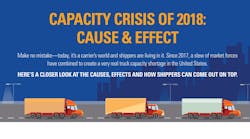A number of factors have been at play contributing to the presently stretched freight capacity and it's a seller's market, but there are strategies shippers can look to in helping control costs, according to CLX Logistics, a transportation and supply chain management systems provider.
The strong economy that has grown close to $5 trillion since 2008 has exponentially affected the amount of goods sold around the globe, and this number is expected to head upwards another 2.5% in the next year. In an infographic CLX published examining the situation for freight, one of the drivers of growth has been the US. holiday season, which saw a spike in sales last year of 4.9%, the biggest increase since 2011.
An element that caught the freight industry off guard was a drastic change in weather last winter—specifically, an 18-degree temperature drop compared to previous winters—that hit the Northeastern U.S. and southeastern Canada the hardest.
These kinds of changes can affect all parts of a supply chain and can result in freight and financial losses. Perishables and other products can be seriously affected, for example, if any additional moisture from colder temperatures enters shipping containers.
Arguably one of the biggest causes of the present capacity crunch is the continued driver shortage. Too few new drivers are coming on while the current driving force ages and retires. CLX Logistics suggests that potential drivers have and are opting for other opportunities, with national unemployment at 4.1% and again, a strong economy.
Meanwhile, the onset of electronic logging devices (ELDs) has further strained capacity, CLX notes, resulting in an anticipated 3-5% reduction in driver productivity and 16% reduction in average miles driven per day as the devices have brought a de facto stricter enforcement of federal Hours of Service rules.
The effects of these factors are threefold, CLX points out: a 5%-plus increase in carrier rates, 18% increase in driver pay, and a 31% increase in freight spot rates.
Those numbers can be a serious challenge for shippers, but CLX suggests ways they can potentially help hold down costs. Strengthen carrier relationships by having a timely loading and unloading process to limit delays, for example, and limiting any changes to loads as much as possible.
Another way to help in that regard is to provide clean restrooms and lunch/break rooms for carriers' drivers. These comparatively small efforts can mean a lot to drivers and go a long way toward providing a more positive atmosphere between carriers and shippers.
Shippers can also invest in their own private or a dedicated fleet. A private fleet means captive capacity to support your freight needs, while a dedicated fleet can provide reliable capacity for the shipper and reliable freight for the carrier.
Alternatively, shippers can explore converting truck shipments to intermodal or rail transport, which has its pros and cons, CLX points out. Such a change can lower costs, increase security of goods, and improve the environment and highway safety by effectively removing trucks from the road. On the other hand, it can also mean slower transmit times, less reliability, increased risk of cargo damage, and higher infrastructure costs.
As another possible strategy, CLX suggests shippers tap into 3PL services and carrier networks, which can deliver pre-qualified carriers that are monitored daily as well as access to a broader range of carriers and shipping rates.




